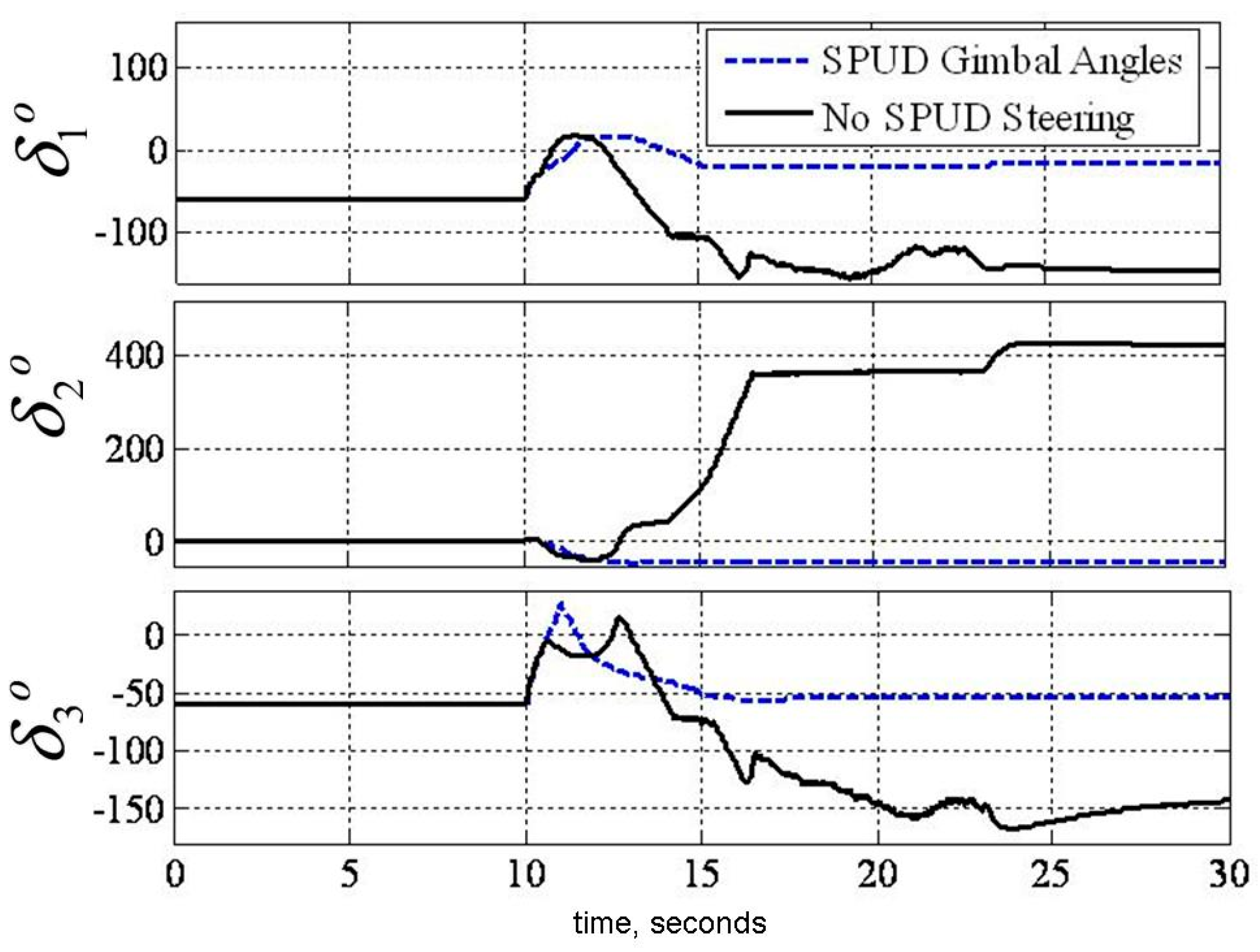Singularity Penetration with Unit Delay (SPUD)
Abstract
:1. Introduction
Literature Review
2. Materials and Methods
2.1. The 3/4 Skewed CMG Array
2.2. Optimal Singularity-Free Skew Angle
2.3. Mixed Skew Angles
2.4. Decoupled Control Analysis
2.5. Singularity Penetration with Unit Delay (SPUD)
3. Results: Verification via Simulation and Validation Experimentally
3.1. Decoupled Control Simulation
3.2. Singularity Penetration Algorithm
3.3. Experimental Verification
3.3.1. Decoupled Control Simulation
3.3.2. Decoupled Control Simulation
4. Discussion
5. Patents
Author Contributions
Conflicts of Interest
References
- Liska, D.J.; Dean, J. Control moment gyros. In Proceedings of the AIAA Second Annual, San Francisco, CA, USA, 26–29 July 1965; pp. 65–405. [Google Scholar]
- Elrod, B.D.; Anderson, G.M. Equilibrium Properties of the Skylab CMG Rotation Law-Case 620; NASA-CR-126140 (Bellcomm TM-72-1022-2); Bellcomm Inc.: Washington, DC, USA, 1972; p. 79. [Google Scholar]
- Kennel, H.F. Steering Law for Parallel Mounted Double-Gimbaled Control Moment Gyros; NASA-TM-X-64930; NASA Marshall Space Flight Center: Huntsville, AL, USA, 1975; p. 34.
- Colburn, B.K.; White, L.R. Computational considerations for a spacecraft attitude control system employing control moment gyro. J. Spacecr. 1977, 14, 40–42. [Google Scholar] [CrossRef]
- Yoshikawa, T. A Steering Law for Three Double Gimbal Control Moment Gyro System; NASA-TM-X-64926; NASA Marshall Space Flight Center: Huntsville, AL, USA, 1975.
- Magulies, G.; Aubrun, J.N. Geometric theory of single-gimbal control moment gyro system. J. Astronaut. Sci. 1978, 26, 159–191. [Google Scholar]
- Tokar, E.N. Problems of gyroscopic stabilizer control. Cosm. Res. 1978, 15, 141–147, (Original: Kosmicheskie Issledovaniya 1978, 16, 179–187). [Google Scholar]
- Kirokawa, H. A Geometric Study of Single Gimbal Control Moment Gyroscopes; Technical Report of Mechanical Engineering Lab; Mechanical Engineering Lab: Chicago, IL, USA, 7 June 1997; No. 175. [Google Scholar]
- Cornick, D.E. Singularity avoidance control laws for single gimbal control moment gyros. In Proceedings of the AIAA Guidance and Control Conference 79-1968, Boulder, CO, USA, 6–8 August 1979; pp. 20–33. [Google Scholar]
- Kurokawa, H.; Yajima, N.; Usui, S. A CMG attitude control system for balloon use. In Proceedings of the 14th International Symposium on Space Technology and Science (ISTS), Okyo, Japan, 27 May–1 June 1984; pp. 1211–1216. [Google Scholar]
- Kurokawa, H.; Yajima, N.; Usui, S. A New steering law of a single gimbal CMG system of pyramid configuration. In Proceedings of the IFAC Automatic Control in Space, Toulouse, France, 24–28 June 1985; pp. 251–257. [Google Scholar]
- Bauer, S.R. Difficulties encountered in steering single gimbal CMGs. In Space Guidance and Navigation Memo No. 10E-87-09; The Charles Stark Draper Laboratory, Inc.: Cambridge, MA, USA, 1987. [Google Scholar]
- Bedrossian, N.S. Steering Law Design for Redundant Single Gimbal Control Moment Gyro Systems, NASA-CR-172008. Master’s Thesis, Massachusetts Institute of Technology, Cambridge, MA, USA, 1987; p. 138, CSDL-T-965. [Google Scholar]
- Bedrossian, N.S.; Paradiso, J.; Bergmann, E.V.; Rowell, D. Steering law design for redundant single-gimbal control moment gyroscope. AIAA J. Guid. Control Dyn. 1990, 13, 1083–1089. [Google Scholar] [CrossRef]
- National Aeronautics and Space Administration Marshall Space Flight Center (NASA MSFC). A Comparison of CMG Steering Laws for High Energy Astronomy Observatories (HEAOS); NASA TM X-64727; NASA Marshall Space Flight Center: Huntsville, AL, USA, 1972; p. 127.
- Linden, S.P. Precision CMG control for high-accuracy pointing. In Proceedings of the AIAA Guidance and Control Conference, Key Biscayne, FL, USA, 20–22 August 1973; AIAA No. 73-871, p. 7. [Google Scholar]
- Rybak, S.C. Achieving ultrahigh accuracy with a body pointing CMG/RW control system. In Proceedings of the AIAA Guidance and Control Conference, Key Biscayne, FL, USA, 20–22 August 1973; AIAA No. 73-871, p. 7. [Google Scholar]
- Vadali, S.R.; Oh, H.S.; Walker, S.R. Preferred gimbal angles for single gimbal control moment gyros. J. Guid. 1990, 13, 1090–1095. [Google Scholar] [CrossRef]
- Seltzer, S.M. CMG-Induced LST Dynamics; NASA-TM-X-64833; NASA Marshall Space Flight Center: Huntsville, AL, USA, 1974; p. 80.
- Sands, T.; Armani, C. Analysis, Correlation, and Estimation for Control of Material Properties. J. Mech. Eng. Autom. 2018, 8, 7–31. [Google Scholar] [CrossRef]
- Sands, T. Experimental Sensor Characterization. J. Space Explor. 2018, 7, 140. [Google Scholar]
- Astrom, K.; Wittenmark, B. Adaptive Control, 2nd ed.; Addison Wesley Longman: Boston, MA, USA, 1995. [Google Scholar]
- Slotine, J.; Benedetto, M. Hamiltonian adaptive control of spacecraft. IEEE Trans. Autom. Control 1990, 35, 848–852. [Google Scholar] [CrossRef]
- Slotine, J.; Li, W. Applied Nonlinear Control; Pearson Publishers: Cambridge, MA, USA, 1990; Chapter 8. [Google Scholar]
- Fossen, T.I. Comments on Hamiltonian adaptive control of spacecraft. IEEE Trans. Autom. Control 1993, 38, 671–672. [Google Scholar] [CrossRef]
- Sands, T. Fine Pointing of Military Spacecraft. Ph.D. Dissertation, Naval Postgraduate School, Monterey, CA, USA, 2007. [Google Scholar]
- Sands, T.; Lorenz, R. Physics-Based Automated Control of Spacecraft. In Proceedings of the AIAA Space 2009 Conference and Exposition, Pasadena, CA, USA, 14–17 September 2009. [Google Scholar]
- Sands, T. Physics-Based Control Methods. In Advancements in Spacecraft Systems and Orbit Determination; In-Tech Publishers: Rijeka, Croatia, 2012; pp. 29–54. [Google Scholar]
- Sands, T. Improved Magnetic Levitation via Online Disturbance Decoupling. Phys. J. 2015, 1, 272–280. [Google Scholar]
- Sands, T. Nonlinear-Adaptive Mathematical System Identification. Computation 2017, 5, 47. [Google Scholar] [CrossRef]
- Sands, T. Phase Lag Elimination at All Frequencies for Full State Estimation of Spacecraft Attitude. Phys. J. 2017, 3, 1–12. [Google Scholar]
- Kim, J.; Sands, T.; Agrawal, B. Acquisition, Tracking, and Pointing Technology Development for Bifocal Relay Mirror Spacecraft. In Proceedings of the Defense and Security Symposium, Orlando, FL, USA, 7 May 2007; Volume 6569. [Google Scholar]
- Nakatani, S.; Sands, T. Autonomous Damage Recovery in Space. Int. J. Autom. Control Intell. Syst. 2016, 2, 23–36. [Google Scholar]
- Nakatani, S.; Sands, T. Simulation of Spacecraft Damage Tolerance and Adaptive Controls. In Proceedings of the IEEE Aerospace Proceedings, Big Sky, MT, USA, 1–8 March 2014. [Google Scholar]
- Nakatani, S.; Sands, T. Battle-damage Tolerant Automatic Controls. Electr. Electron. Eng. 2018, 8, 10–23. [Google Scholar] [CrossRef]
- Heidlauf, P.; Cooper, M. Nonlinear Lyapunov Control Improved by an Extended Least Squares Adaptive Feed forward Controller and Enhanced Luenberger Observer. In Proceedings of the International Conference and Exhibition on Mechanical & Aerospace Engineering, Las Vegas, NV, USA, 2–4 October 2017. [Google Scholar]
- Cooper, M.; Heidlauf, P.; Sands, T. Controlling Chaos—Forced van der Pol Equation. Mathematics 2017, 5, 70. [Google Scholar] [CrossRef]
- Wie, B. Robust Singularity Avoidance in Satellite Attitude Control. U.S. Patent 6039290 A, 21 March 2000. [Google Scholar]
- Sands, T.; Kim, J.; Agrawal, B. 2H Singularity-Free Momentum Generation with Non-Redundant Single Gimbaled Control Moment Gyroscopes. In Proceedings of the 45th IEEE Conference on Decision & Control, San Diego, CA, USA, 13–15 December 2006. [Google Scholar]
- Sands, T. Control Moment Gyroscope Singularity Reduction via Decoupled Control. In Proceedings of the IEEE SEC Proceedings, Atlanta, GA, USA, 5–8 March 2009. [Google Scholar]
- Sands, T.; Kim, J.; Agrawal, B. Nonredundant Single-Gimbaled Control Moment Gyroscopes. J. Guid. Control Dyn. 2012, 35, 578–587. [Google Scholar] [CrossRef] [Green Version]
- Sands, T. Experiments in Control of Rotational Mechanics. Int. J. Autom. Control Intell. Syst. 2016, 2, 9–22. [Google Scholar]
- Agrawal, B.; Kim, J.; Sands, T. Method and Apparatus for Singularity Avoidance for Control Moment Gyroscope (CMG) Systems without Using Null Motion. U.S. Patent 9567112 B1, 14 February 2017. [Google Scholar]
- Sands, T.; Kenny, T. Experimental Piezoelectric System Identification. J. Mech. Eng. Autom. 2017, 7, 179–195. [Google Scholar]
- Sands, T. Space System Identification Algorithms. J. Space Explor. 2018, 6, 138. [Google Scholar]
- Sands, T. Space Mission Analysis and Design for Electromagnetic Suppression of Radar. Int. J. Electromag Apps 2018. submitted. [Google Scholar]
- Mihalik, R.; Camacho, H.; Sands, T. Continuum of Learning: Combining Education, Training, and Experiences. Education 2018, 8, 9–13. [Google Scholar] [CrossRef]
- Sands, T.; Camacho, H.; Mihalik, R. Education in Nuclear Deterrence and Assurance. J. Def. Manag. 2017, 7. [Google Scholar] [CrossRef]
- Sands, T.; Lu, D.; Chu, J.; Cheng, B. Developments in Angular Momentum Exchange. Int. J. Aero. Sci. 2018, 6. submitted. [Google Scholar]
- Mihalik, R.; Camacho, H.; Crook, M.; Sands, T.; Nichols, T. Study on the 2018 Nuclear Posture Review. Soc. Sci. 2018, unpublished manuscript. [Google Scholar]
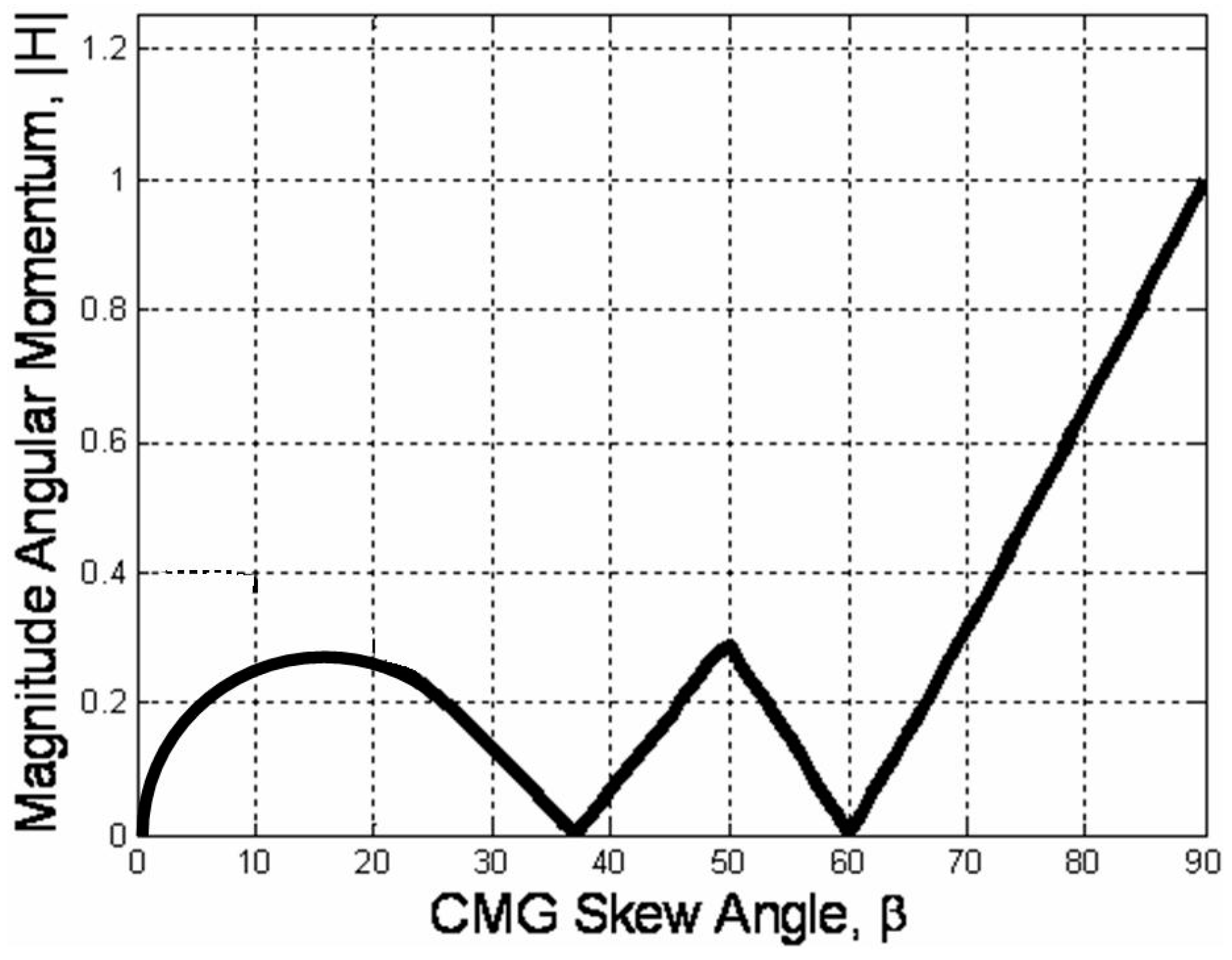
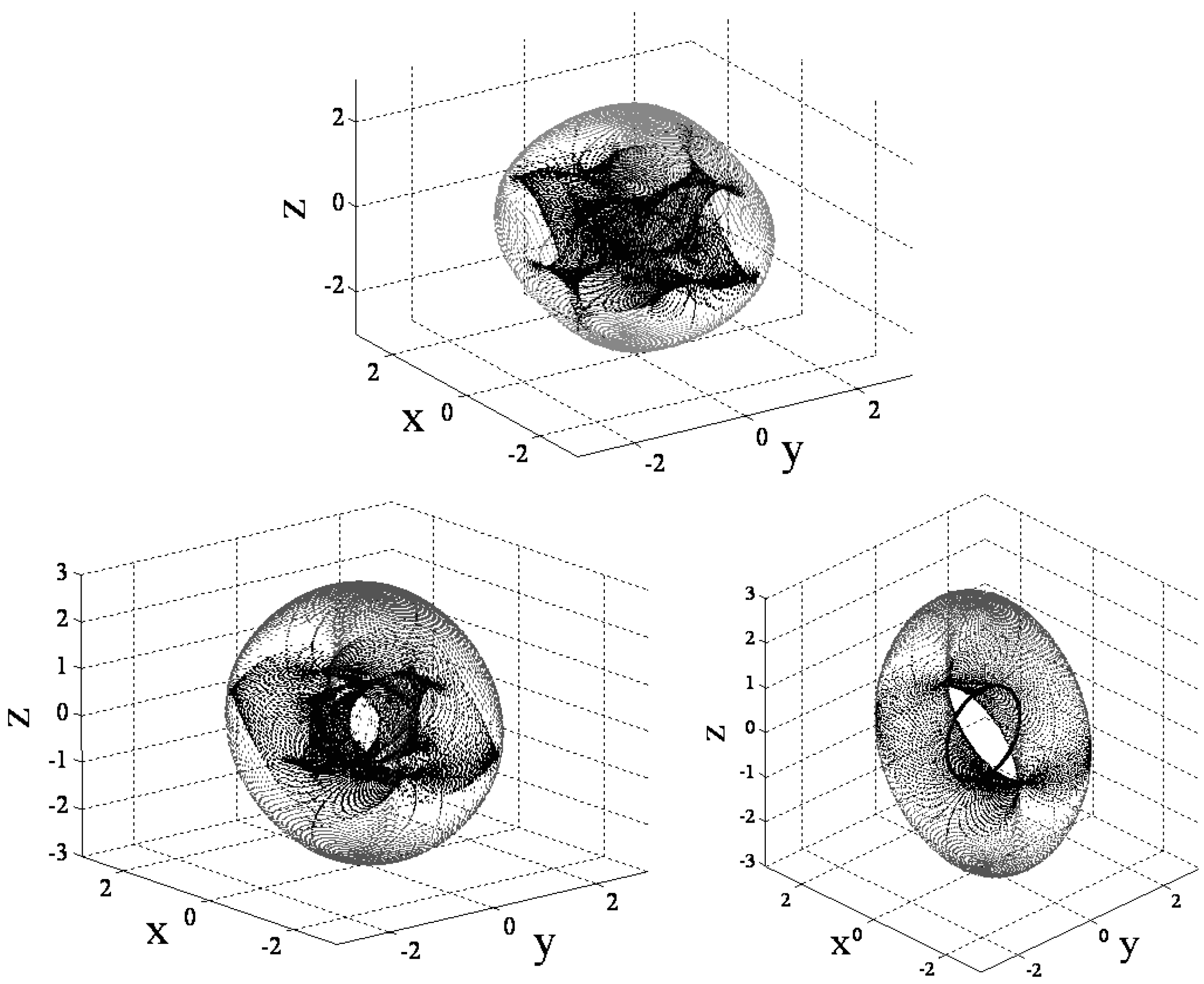
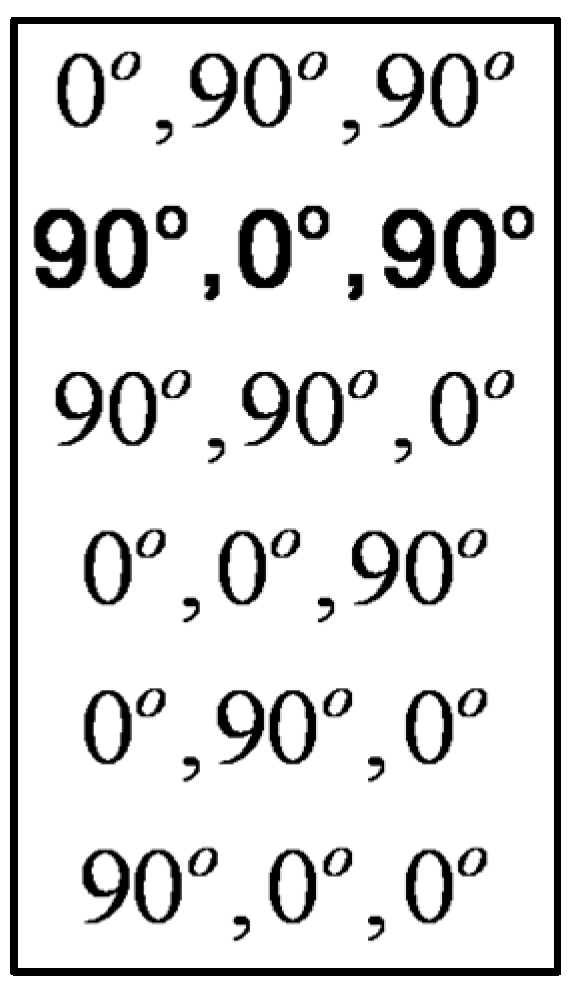
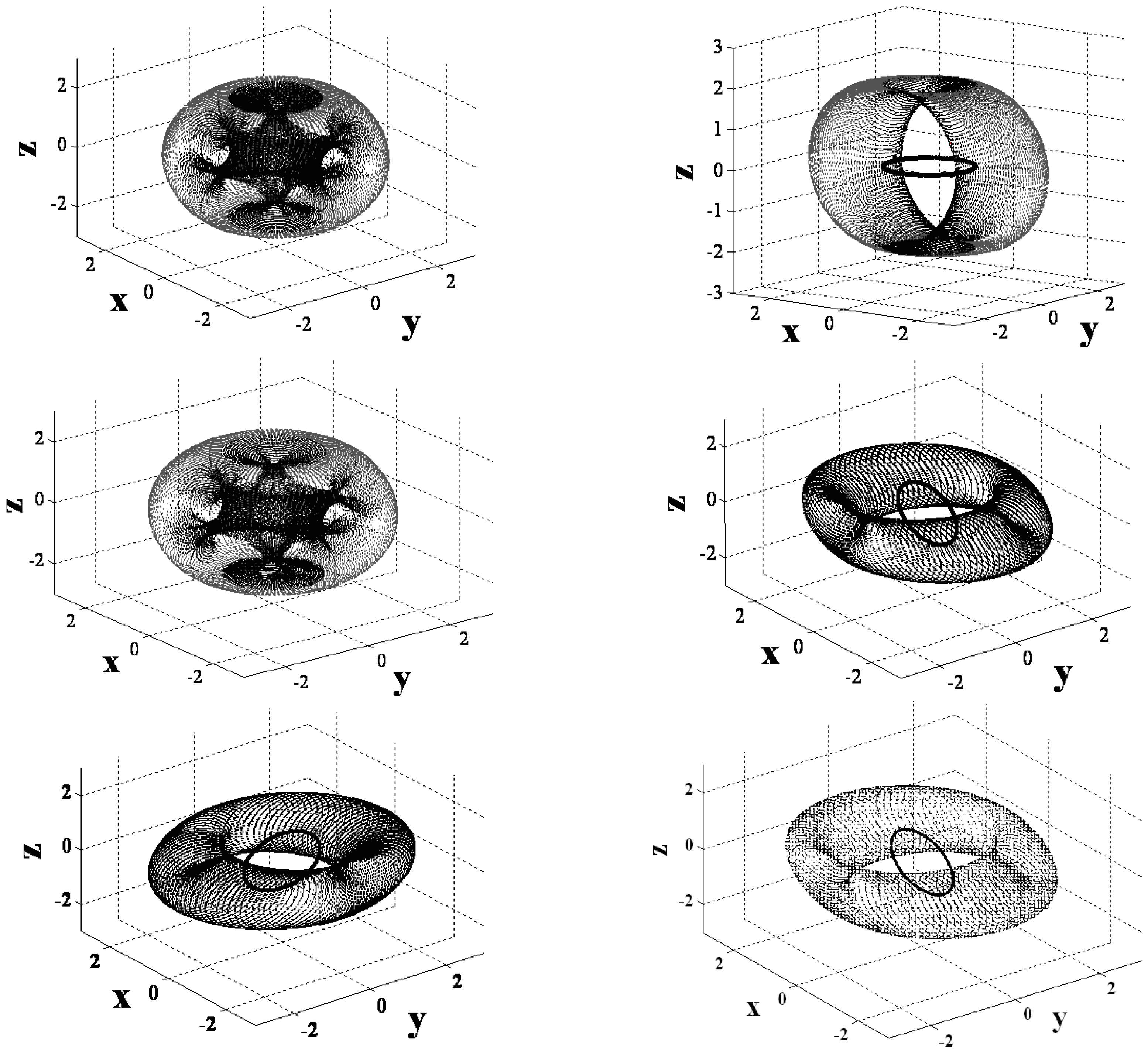
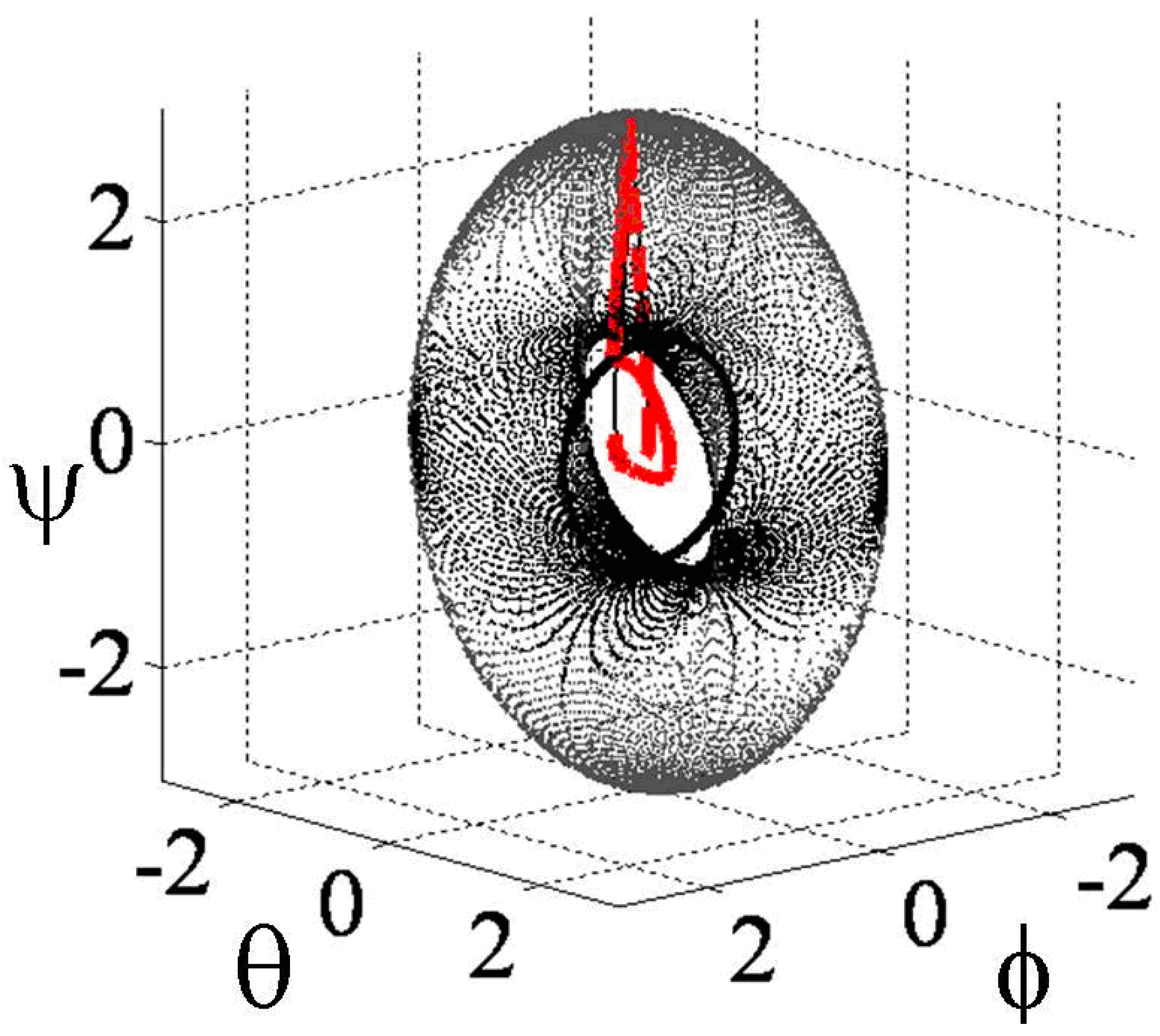
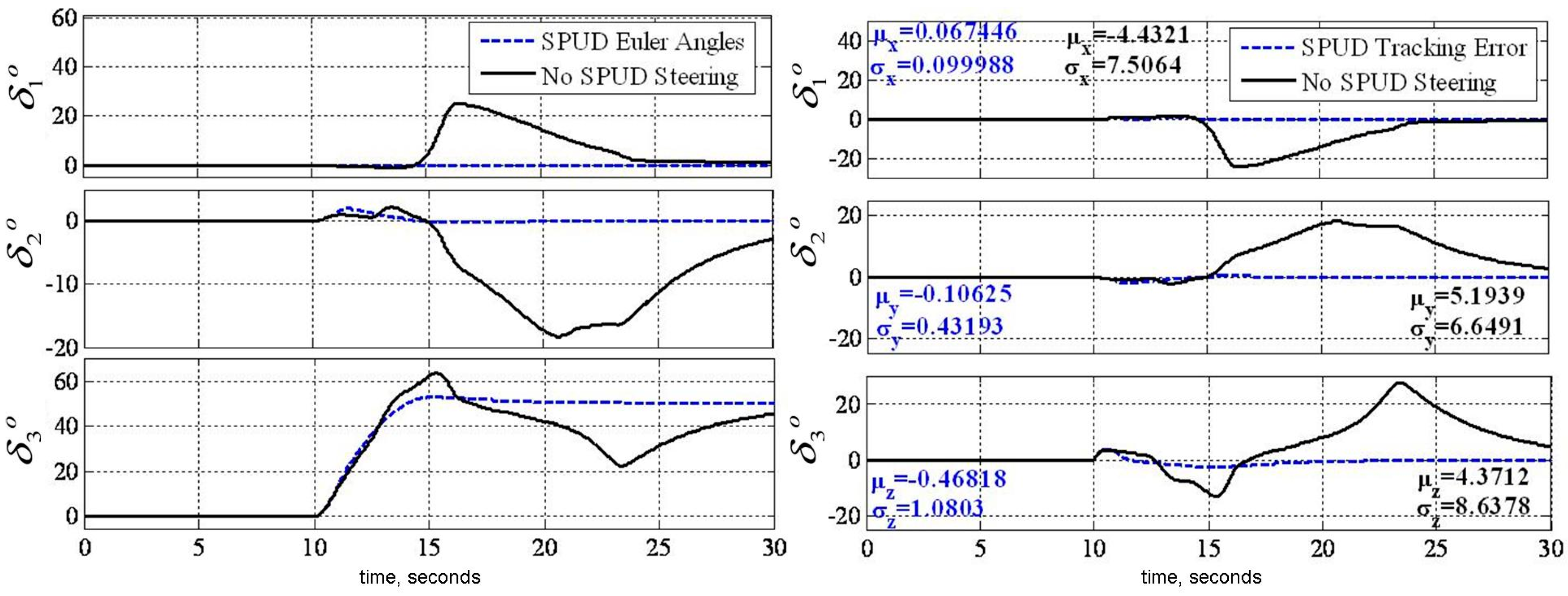
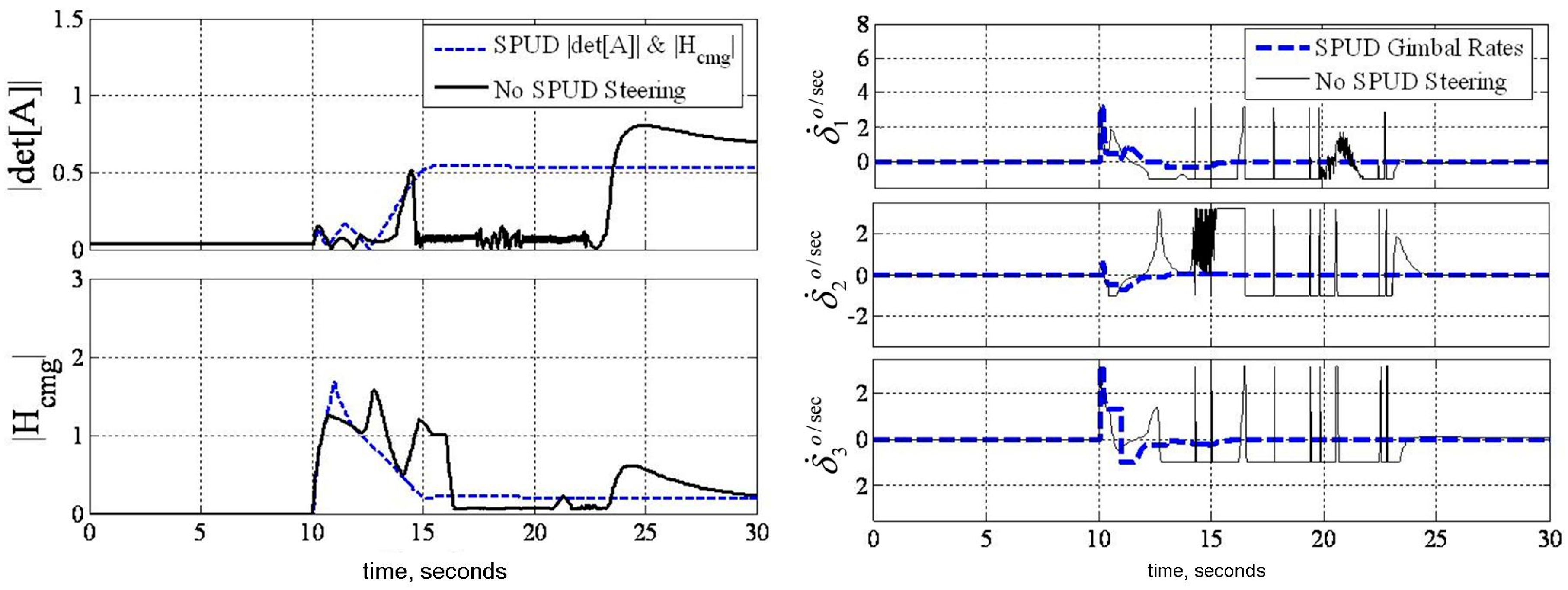


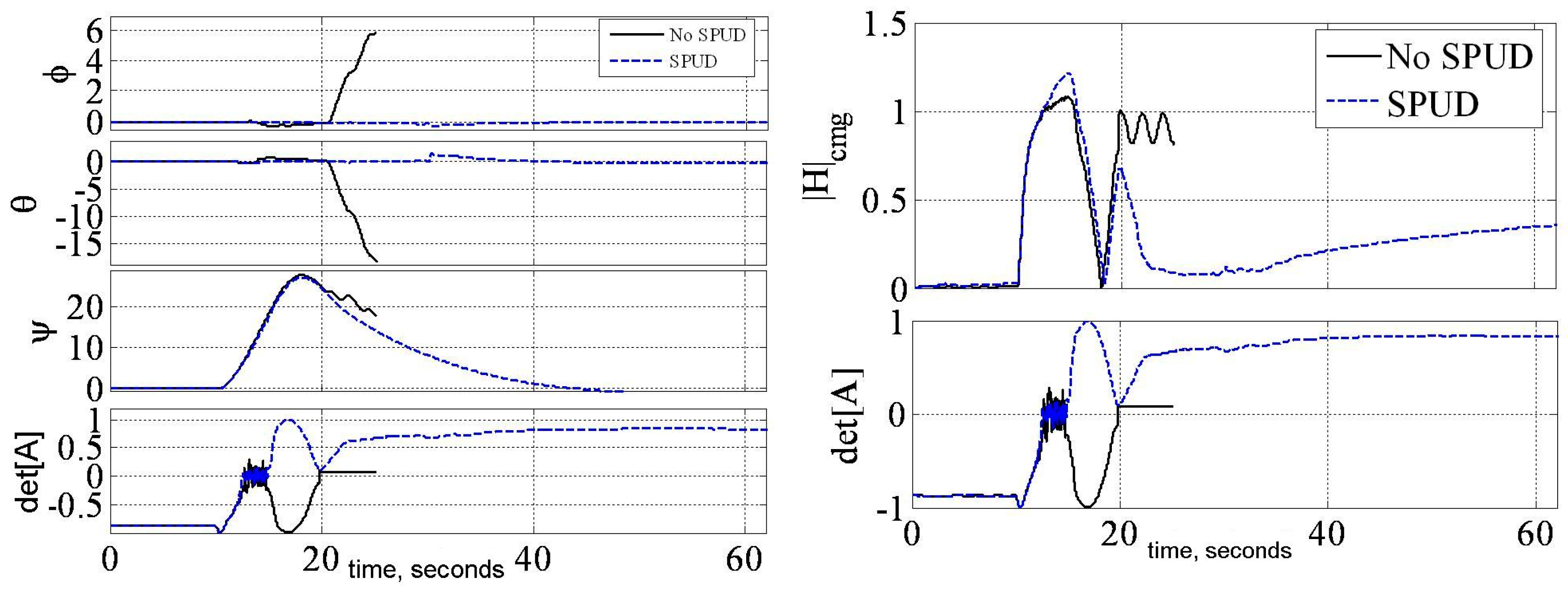
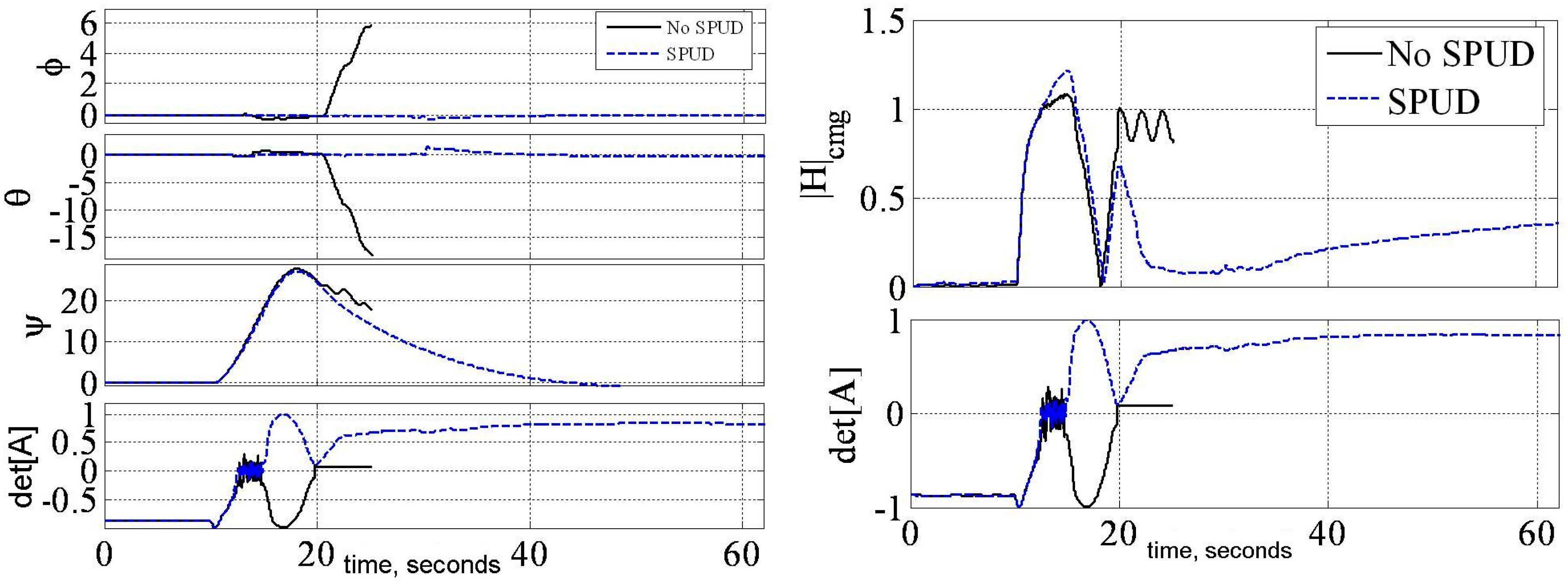

© 2018 by the authors. Licensee MDPI, Basel, Switzerland. This article is an open access article distributed under the terms and conditions of the Creative Commons Attribution (CC BY) license (http://creativecommons.org/licenses/by/4.0/).
Share and Cite
Sands, T.; Kim, J.J.; Agrawal, B. Singularity Penetration with Unit Delay (SPUD). Mathematics 2018, 6, 23. https://doi.org/10.3390/math6020023
Sands T, Kim JJ, Agrawal B. Singularity Penetration with Unit Delay (SPUD). Mathematics. 2018; 6(2):23. https://doi.org/10.3390/math6020023
Chicago/Turabian StyleSands, Timothy, Jae Jun Kim, and Brij Agrawal. 2018. "Singularity Penetration with Unit Delay (SPUD)" Mathematics 6, no. 2: 23. https://doi.org/10.3390/math6020023





